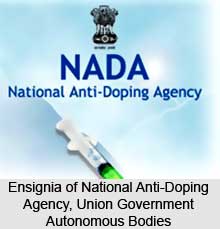 The National Anti-Doping Agency (NADA) is the national organization responsible for promoting, coordinating, and monitoring the doping control programme in sports in all its forms in the country. NADA works towards a vision of `dope free` sport in India. The NADA has been established by the Government of India under the Ministry of Youth Affairs and Sports.
The National Anti-Doping Agency (NADA) is the national organization responsible for promoting, coordinating, and monitoring the doping control programme in sports in all its forms in the country. NADA works towards a vision of `dope free` sport in India. The NADA has been established by the Government of India under the Ministry of Youth Affairs and Sports.
Functions of NADA
The prime function of the NADA is adopting and implementing anti-doping rules and policies which conform with the World Anti-Doping Code. The World Anti-Doping Code is the document that harmonizes regulations regarding anti-doping in sport across all sports and all countries of the world. The Code provides a framework for anti-doping policies, rules, and regulations for sport organizations and public authorities so that there may be a level playing field for all athletes worldwide. The NADA is also responsible for co-operating with other sports related organizations and other anti-doping organizations, encouraging reciprocal testing between National Anti-Doping Organisations. The NADA also promotes anti-doping research and education.
The World Anti-Doping Agency annually updates the List of Prohibited Substances and Methods. The list is the International Standard defining what is prohibited in-competition and out of competition. The list also indicates whether particular substances are banned in particular sports. NADA is responsible to implement an effective number of in-competition and out-of-competition tests on the athletes in its registered testing pool. This includes international and national level athletes being tested by NADA. The NADA develops a test distribution plan and allocates the number of samples for each sport or discipline required for effective deterrence. The plan includes out-of-competition testing, in-competition testing, and may include blood as well as urine collection.
In-Competition Testing
NADA coordinates in-competition testing so that there is only one organization testing at one event. Criteria for the selection of athletes are predetermined, based on the regulations of the relevant IF or event ruling body. Athletes are notified of their selection for testing immediately following competition, and sample collection takes place in accordance with the International Standard for Testing. Samples are analyzed for "in-competition substances" as outlined in the WADA Prohibited List.
Out-of-Competition Testing
Out-of-competition testing or any testing done outside of an event ensures that all athletes can be tested at any time and at any place. An athlete identified in the registered testing pool by NADA is required to provide accurate and current whereabouts information. This information is usually required on a half-yearly basis, although NADA may have specific requirements, and updates are required if the athlete`s plans change. Whereabouts information may include details such as home address, work schedule, training venues and schedule, and competition schedule anything which will help a Doping Control Officer (DCO) find the athlete on any given day. International or national level athletes identified in a registered testing pool are responsible under the Code for providing whereabouts information to NADA. Failure to do so in accordance with anti-doping regulations may be considered an anti-doping rule violation and may result in a sanction.




















